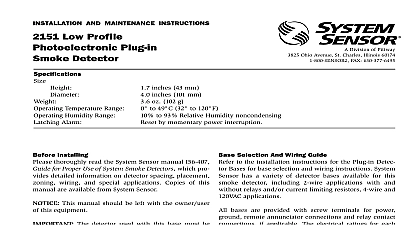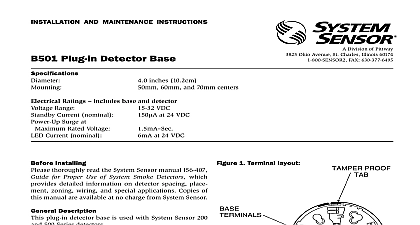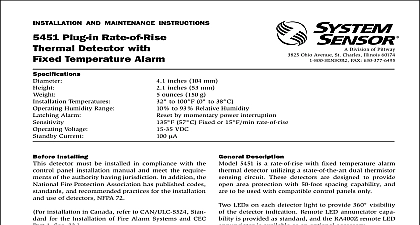System Sensor 1251 Install and Maint Instructions

File Preview
Click below to download for free
Click below to download for free
File Data
| Name | system-sensor-1251-install-and-maint-instructions-6591872340.pdf |
|---|---|
| Type | |
| Size | 1.05 MB |
| Downloads |
Text Preview
INSTALLATION AND MAINTENANCE INSTRUCTIONS Plug in Intelligent Ionization with Communications Division of Pittway 3825 Ohio Avenue St Charles Illinois 60174 FAX 630 377 6495 Voltage Range Avg Standby Current Alarm Current LED on Humidity Range Temperature Range to 32 VDC 24 VDC one communication every 5 sec with LED blink enabled mA 24 VDC to 93 Relative Humidity noncondensing to 49 32 to 120 inches 43 mm installed in B210LP Base inches 155 mm installed in B210LP Base inches 104 mm installed in B501 Base oz 102 g Installing read the system wiring and installation manual I56 This manual includes detailed information on sensor placement zoning and special applications Cop of this manual are available from System Sensor Description Model 1251 intelligent ionization sensor uses a state sensing chamber This sensor is designed to pro open area protection and is intended for use with control panels only Guide to the installation instructions for the plug in base be used As indicated in Figure 1 terminals for power and the optional RA400Z Remote Annunciator are in the base Base Models B210LP shown in Figure and B501 are electrically identical All wiring must conform to all applicable codes and regulations Verify that all sensor bases are installed and that of the wiring is correct at each base LEDs on each sensor light to provide a local visible indication The LEDs can be latched on by code from the control panel for an alarm indication LEDs can also be unlatched to the normal condition by command Remote LED annunciator capability is also as an optional accessory RA400Z loop power before installing sensors Sensor Installation Set the sensor to the desired address and record that on the label attached to the base Insert the sensor into the base and rotate it clockwise it drops into place Continue to rotate the sensor until it locks into the covers are an effective way to limit the entry of dust smoke detector sensing chambers However they may completely prevent airborne dust particles from enter the detector Therefore System Sensor recommends the of detectors before beginning construction or other producing activity sure to remove dust covers from any sensors that were in place during construction as part of returning the to service Manuals Online ANNUNCIATOR Do not loop wire under terminal 1 or 2 wire run to provide supervision of connections 1 J mw a a oa wz Q PJIQN A shown in Figure 2 Both LEDs should latch on within 30 seconds indicat an alarm and annunciating the panel Calibrated Sensitivity Test MOD400R Use the MOD400R Test Module with a digital or analog to test calibrated detector sensitivity as de in the test module manual Aerosol Generator in accordance with NFPA 72 Gemini Model 501 aerosol generator can be used to the sensor Set the generator to represent 4 ft to obscuration following the instructions in the gen manual Use a bowl shaped applicator to apply to the sensor It should alarm after 30 seconds Tamper Resistance Model 1251 includes a tamper resistant capability that its removal from the bracket without the use of tool Refer to the base manual for details on making of this capability After all sensors have been installed apply power to the See Figure 2 Test the sensor by positioning a test mag M02 24 against the sensor plastic just to the left of The alarm level should be recognized at the panel the LED controlled by communication command the panel Reset the sensor by communication command from the must be tested after installation and following maintenance However before testing notify the authorities that the smoke detector system is under maintenance and the system will be temporarily out service Disable the zone or system undergoing mainte to prevent unwanted alarms addition check to ensure that the LEDs blink If they do power has been lost to the detector check the wiring it is defective return it for repair the sensors as follows Test Magnet Model M02 24 optional Test the sensor by positioning the optional test mag against the sensor plastic just to the left of LED1 Manuals Online 2 Test Magnet positioning 3 cleaning notify the proper authorities that the sys is undergoing maintenance and will be temporarily out service Disable the system to prevent unwanted alarms Remove the sensor to be cleaned from the system Remove the sensor cover Use a small standard screw to release each of the four cover removal tabs that the cover in place Vacuum the outside of the screen carefully without re it Remove the sensor screen Pull the screen straight away the sensing chamber until it snaps out of place Re screens are available Use a vacuum cleaner or clean compressed air to re dust and debris from the sensing chamber Reinstall or replace the sensing chamber screen by plac it over the sensing chamber Rotate the screen until it into place Reinstall the sensor cover Use the test module socket LEDs to align the cover with the sensor Snap the into place When all sensors have been cleaned restore power to system and test the sensor s as described in the section of this manual REMOVAL D Manuals Online Limitations of Property Protection Smoke Detectors smoke detector is designed to activate and initiate emergency ac but will do so only when it is used in conjunction with an authorized alarm system This detector must be installed in accordance with standard 72 detectors will not work without power AC or DC powered detectors will not work if the power supply is cut off detectors will not sense fires which start where smoke does not the detectors Smoldering fires typically do not generate a lot of which is needed to drive the smoke up to the ceiling where the detector is usually located For this reason there may be large de in detecting a smoldering fire with either an ionization type detector a photoelectric type detector Either one of them may alarm only after has initiated which will generate the heat needed to drive the to the ceiling from fires in chimneys in walls on roofs or on the other side of a door s may not reach the smoke detector and alarm it A detector detect a fire developing on another level of a building quickly or at For these reasons detectors shall be located on every level and in bedroom within a building detectors have sensing limitations too Ionization detectors and detectors are required to pass fire tests of the flaming and type This is to ensure that both can detect a wide range of of fires Ionization detectors offer a broad range of fire sensing capa but they are somewhat better at detecting fast flaming fires than smoldering fires Photoelectric detectors sense smoldering fires better flaming fires which have little if any visible smoke Because fires de in different ways and are often unpredictable in their growth nei type of detector is always best and a given detector may not always early warning of a specific type of fire general detectors cannot be expected to provide warnings for fires re from inadequate fire protection practices violent explosions es gases which ignite improper storage of flammable liquids like solvents which ignite other similar safety hazards arson smok in bed children playing with matches or lighters etc Smoke detectors in high air velocity conditions may have a delay in alarm due to dilu of smoke densities created by frequent and rapid air exchanges Addi high air velocity environments may create increased dust demanding more frequent maintenance detectors cannot la


